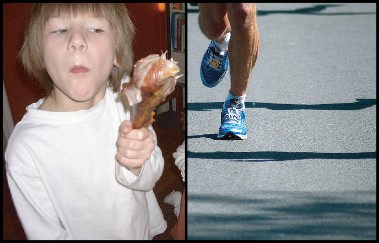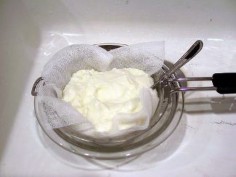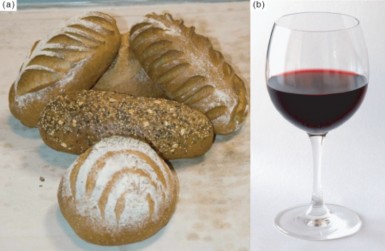Lesson 5.3: Anaerobic Respiration: ATP, New Fuels, and Yogurt without Oxygen
Lesson 5.3: Anaerobic Respiration: ATP, New Fuels, and Yogurt without Oxygen
Lesson Objectives
Distinguish between obligate aerobes, obligate anaerobes, and facultative anaerobes.
Explain that, in the absence of oxygen fermentation reactions must regenerate NAD+ in order for glycolysis to continue making ATP.
Discuss how your muscles continue to work for you even when your respiratory and cardiovascular system can no longer keep up a continuous supply of oxygen.
Identify yourself as “sprinter” or “endurance runner” and predict the type of muscle fiber (red or white) which predominates in your body.
Describe how bacteria, including those we employ to make yogurt, make ATP in the absence of oxygen.
Compare and contrast alcoholic and lactic acid fermentation pathways.
Outline the process used to produce fuel from corn.
Explain how we employ anaerobic organisms to make bread, beer, and wine.
Compare the energy efficiency of aerobic cellular respiration to that of fermentation.
List the advantages of anaerobic over aerobic respiration.
Explain why vertebrate muscles use both aerobic and anaerobic pathways to make ATP.
Introduction
After the photosynthetic “oxygen catastrophe” challenged life between 2.5 and 3 billion years ago, evolution rebounded with biochemical pathways to harness and protect against oxygen’s power. Today, most organisms use O2 in aerobic respiration to produce ATP. Almost all animals, most fungi, and some bacteria are obligate aerobes, which require oxygen. Some plants and fungi and many bacteria retain the ability to make ATP without oxygen. These facultative anaerobes use ancient anaerobic pathways when oxygen is limited. A few bacteria remain as obligate anaerobes, which die in the presence of oxygen and depend on only the first (anaerobic) stage of cellular respiration.
Aerobic and anaerobic pathways diverge after glycolysis splits glucose into two molecules of pyruvate:
![]()
Pyruvate still contains a great deal of chemical energy. If oxygen is present, pyruvate enters the mitochondria for complete breakdown by the Krebs Cycle and electron transport chain. If oxygen is not present, cells must transform pyruvate to regenerate NAD+ in order to continue making ATP. Two different pathways accomplish this with rather famous products: lactic acid and ethyl alcohol (Figure 5.19). Making ATP in the absence of oxygen by glycolysis alone is known as fermentation. Therefore, these two pathways are called lactic acid fermentation and alcoholic fermentation. If you lack interest in organisms, such as yeast and bacteria, which have “stuck with” the anaerobic tradition, the products of these chemical reactions may still intrigue you. Fermentation makes bread, yogurt, beer, wine, and some new biofuels. In addition, some of your body’s cells are facultative anaerobes, retaining one of these ancient pathways for short-term, emergency use.

Lactic Acid Fermentation: Muscle Cells and Yogurt
For chicken or turkey dinners, do you prefer light meat or dark? Do you consider yourself a sprinter, or a distance runner? (Figure 5.20)

Are Drumsticks and Athletic Prowess Related?
Yes! Muscle color reflects its specialization for aerobic or anaerobic metabolism. Although humans are obligate aerobes, our muscle cells have not given up on ancient pathways which allow them to keep producing ATP quickly when oxygen runs low. The difference is more pronounced in chickens and grouse (Figure 5.21), which stand around all day on their legs. For long periods of time, they carry out aerobic respiration in their “specialized- for-endurance” red muscles. If you have ever hunted grouse, you know that these birds “flush” with great speed over short distances. Such “sprinting” flight depends on anaerobic respiration in the white cells of breast and wing muscle. No human muscle is all red or all white, but chances are, if you excel at running short distances or at weight lifting, you have more white glycolytic fibers in your leg muscles. If you run marathons, you probably have more red oxidative fibers.
You probably were not aware that muscle cells “ferment.” Lactic acid fermentation is the type of anaerobic respiration carried out by yogurt bacteria (Lactobacillus and others) and by your own muscle cells when you work them hard and fast. Converting pyruvate to 3-carbon lactic acid (see Figure below) regenerates NAD+ so that glycolysis can continue to make ATP in low-oxygen conditions.


![]()
For Lactobacillusbacteria, the acid resulting from fermentation kills bacterial competitors in buttermilk, yogurt, and some cottage cheese. The benefits extend to humans who enjoy these foods, as well (Figure 5.22).
You may have noticed this type of fermentation in your own muscles, because muscle fatigue and pain are associated with lactic acid. Keep this in mind, however, as we discuss a second type of fermentation, which produces alcohol. Imagine what would happen as you ran a race if muscle cells conducted alcoholic rather than lactic acid fermentation!
Alcoholic Fermentation: A “New” Source of Energy?
Have you fueled your car with corn? You have, if you bought gas within the city of Portland, Oregon. Portland was the first city to require that all gasoline sold within the city limits

Figure 5.22: Lactobacillus bacteria use the same type of anaerobic respiration as our muscle cells. Lactic acid reduces competition from other bacteria, and flavors yogurt, as well! (4)
contain at least 10% ethanol. By mid-2006, nearly 6 million “flex-fuel” vehicles – which can use gasoline blends up to 85% ethanol (E85 – Figure 5.23) were traveling US roads. This “new” industry employs an “old” crew of yeast and bacteria to make ethanol by an even older biochemical pathway – alcoholic fermentation. Many people consider “renewable” biofuels such as ethanol a partial solution to the declining availability of “nonrenewable” fossil fuels. Although controversy still surrounds the true efficiency of producing fuel from corn, ethanol is creeping into the world fuel resource picture (Figure 5.24).

You are probably most familiar with the term ”fermentation” in terms of alcoholic beverages. You may not have considered that the process is actually a chemical reaction certain bacteria and yeasts use to make ATP. Like lactic acid fermentation, alcoholic fermentation processes pyruvate one step further in order to regenerate NAD+ so that glycolysis can continue to make ATP. In this form of anaerobic respiration, pyruvate is broken down into ethyl alcohol and carbon dioxide:
![]()

We have domesticated yeast (Figures 5.25 and Figure 5.26) to carry out this type of anaerobic respiration for many commercial purposes. When you make bread, you employ the yeast to make the bread “rise” by producing bubbles of carbon dioxide gas. Why do you suppose that eating bread does not intoxicate you?
Brewers of beer and wine use yeast to add alcohol to beverages. Traditional varieties of yeast not only make but also limit the quantity of alcohol in these beverages, because above 18% by volume, alcohol becomes toxic to the yeast itself! We have recently developed new strains of yeast which can tolerate up to 25% alcohol by volume. These are used primarily in the production of ethanol fuel.
Human use of alcoholic fermentation depends on the chemical energy remaining in pyruvate after glycolysis. Transforming pyruvate does not add ATP to that produced in glycolysis, and for anaerobic organisms, this is the end of the ATP-producing line. All types of anaerobic respiration yield only 2 ATP per glucose. In the next section, we will compare the advantages and disadvantages of aerobic and anaerobic respiration.
Aerobic vs. Anaerobic Respiration: A Comparison
As aerobes in a world of aerobic organisms, we tend to consider aerobic respiration “better” than fermentation. In some ways, it is. However, anaerobic respiration has persisted far longer on this planet, through major changes in atmosphere and life. There must be value


in this alternative way of making ATP. In this last section, we will compare the advantages and disadvantages of these two types of respiration.
A major argument in favor of aerobic over anaerobic respiration is overall energy production. Without oxygen, organisms can only break 6-carbon glucose into two 3-carbon molecules. As we saw earlier, glycolysis releases only enough energy to produce two (net) ATP per molecule of glucose. In contrast, aerobic respiration breaks glucose all the way down to CO2, producing up to 38 ATP. Membrane transport costs can reduce this theoretical yield, but aerobic respiration consistently produces at least 15 times as much ATP as anaerobic respiration. This vast increase in energy production probably explains why aerobic organisms have come to dominate life on earth. It may also explain how organisms were able to increase in size, adding multicellularity and great diversity.
However, anaerobic pathways persist, and a few obligate anaerobes have survived over 2 billion years beyond the evolution of aerobic respiration. What are the advantages of fer- mentation?
One advantage is available to organisms occupying the few anoxic (lacking oxygen) niches remaining on earth. Oxygen remains the highly reactive, toxic gas which caused the “Oxygen Catastrophe.” Aerobic organisms have merely learned a few tricks – enzymes and antioxidants
to protect themselves. Organisms living in anoxic niches do not run the risk of oxygen exposure, so they do not need to spend energy to build these elaborate chemicals.
Individual cells which experience anoxic conditions face greater challenges. We mentioned earlier that muscle cells “still remember” anaerobic respiration, using lactic acid fermentation to make ATP in low-oxygen conditions. Brain cells do not “remember”, and consequently cannot make any ATP without oxygen. This explains why death follows for most humans who endure more than four minutes without oxygen.
Variation in muscle cells gives further insight into some benefits of anaerobic respiration. In vertebrate muscles, lactic acid fermentation allows muscles to produce ATP quickly during short bursts of strenuous activity. Muscle cells specialized for this type of activity show differences in structure as well as chemistry. Red muscle fibers are “dark” because they have a rich blood supply for a steady supply of oxygen, and a protein, myoglobin, which holds extra oxygen. They also contain more mitochondria, the organelle in which the Krebs cycle and electron transport chain conclude aerobic respiration. White muscle cells are “light” because they lack the rich blood supply, have fewer mitochondria, and store glycogen rather than oxygen. When you eat dark meat, you are eating endurance muscle. When you eat white meat, you are eating muscle built for sprinting.
Each type of muscle fiber has advantages and disadvantages, which reflect their differing biochemical pathways. Aerobic respiration in red muscles produces a great deal of ATP from far less glucose - but slowly, over a long time. Anaerobic respiration in white muscles produces ATP rapidly for quick bursts of speed, but a predator who continues pursuit may eventually catch a white-muscled prey.
In summary, aerobic and anaerobic respiration each have advantages under specific condi- tions. Aerobic respiration produces far more ATP, but risks exposure to oxygen toxicity. Anaerobic respiration is less energy-efficient, but allows survival in habitats which lack oxy- gen. Within the human body, both are important to muscle function. Muscle cells specialized for aerobic respiration provide endurance, and those specialized for lactic acid fermentation support short but intense energy expenditures. Both ways of making ATP play critical roles in life on earth.
Lesson Summary
In the two to three billion years since photosynthesis added oxygen to earth’s atmo- sphere, life has become mostly aerobic. Some organisms and types of cells retain the older, anaerobic pathways for making ATP; these pathways comprise anaerobic respi- ration or fermentation.
Obligate aerobes require oxygen to make ATP. Obligate anaerobes cannot survive in the presence of oxygen, so they occupy only anoxic habitats. Facultative anaerobes make ATP with oxygen, but if oxygen levels become low, they can use fermentation.
Some bacteria, including those we employ to make yogurt, make ATP using lactic acid fermentation; the acid may help reduce competition from other bacteria. Muscle cells can continue to produce ATP when O2 runs low using lactic acid fermentation, but muscle fatigue and pain may result.
Red muscle fibers use mostly aerobic respiration to make ATP for endurance tasks; white muscle fibers use mostly lactic acid fermentation to make ATP quickly for short, intense activities. Human muscles contain a mixture of red and white fibers, but genetics may give sprinters more white fibers, and marathoners more red.
Both alcoholic and lactic acid fermentation pathways change pyruvate in order to continue producing ATP by glycolysis.
Ethanol produced by bacteria through alcoholic fermentation of corn (and perhaps other fuels in the near future) may provide a more renewable fuel for vehicles than the fossil fuels upon which we currently depend. We employ yeasts to help make bread through alcoholic fermentation; as they produce carbon dioxide, the bread dough rises. We employ anaerobic organisms to make beer and wine through alcoholic fermentation; the alcohol content is limited to 18% by volume because levels above that are toxic to these organisms.
Aerobic respiration is far more energy-efficient than anaerobic respiration. Aerobic processes produce up to 38 ATP per glucose. Anaerobic processes yield only 2 ATP per glucose.
Review Questions
Further Reading / Supplemental Links
Classify your own cells as obligate aerobes, obligate anaerobes, or facultative anaerobes, and explain your reasoning. (Although these terms usually apply to whole organisms, assume they can also apply to individual cells within your body).
Identify yourself as a “sprinter” or an “endurance runner” and predict the type of muscle fiber (red or white) which predominates in your body. Explain your reasoning.
Construct a chart which compares alcoholic to lactic acid fermentation, considering at least three different features.
Outline the process used to produce fuel from corn and explain why some consider this fuel “renewable” and preferable to fossil fuels. Research the pros and cons of this fuel.
Explain how fermentation is used to make bread.
If two species of bacteria – one using aerobic respiration and the other using anaerobic respiration - were competing for the same source of glucose in the same environment, which one would out-compete the other? Explain why.
Human cells cannot carry out alcoholic fermentation, yet we use it for many purposes. Analyze its importance to human life.
Explain why both types of fermentation must change pyruvic acid, even though no energy is gained in this conversion.
Indicate the maximum alcohol content of wine and beer, and explain the reason for this limit.
Construct a chart comparing aerobic to anaerobic respiration using at least 5 charac- teristics.
Martin Hoagland, Bert Dodson, and Judith Hauck, Exploring the Way Life Works: The Science of Biology. Jones and Bartlett Publishers, Inc., 2001. Chapter 3: “Energy
Light to Life,” pp. 87-138.
“Biology, Answering the Big Questions of Life/Fermentation student lab” and “Biol- ogy, Answering the Big Questions of Life/Fermentation.“ Wikibooks, last modified 13 March 2007. Available on the web at: http://en.wikibooks.org/wiki/Biology%2C_ Answering_the_Big_Questions_of_Life/Fermentation
Diana C. Linden and Roberta Pollack, “Chart of Important metabolic products.” In
Biology 130 Introduction to Cellular Biochemistry Lectures, Occidental College, last updated 21 October 2000. Available on the web at:
http://departments.oxy.edu/biology/bio130/lectures_2000/metabolic_products. htm
J. Stein Carter, 1996, “Cellular Respiration and Fermentation.” last modified on Tue
02 Nov 2004. Available on the web at:
http://biology.clc.uc.edu/courses/bio104/cellresp.htm
John Kyrk, “Glycolysis.” Cell Biology Animation, 28 April 2007. Available on the web
at: http://www.johnkyrk.com/glycolysis.html.
M.J. Farabee, 1992, 1994, 1997, 1999, 2000, 2001, 2007. “Glycolysis, the Univer- sal Process.” Biobook, Estrella Mountain Community College, last modified 2007. Available on the web at:http://www.emc.maricopa.edu/faculty/farabee/BIOBK/ BioBookGlyc.html
Vocabulary
aerobic With oxygen, or living or occurring only in the presence of oxygen.
alcoholic fermentation The process for making ATP in the absence of oxygen, by con- verting glucose to ethanol and carbon dioxide.
anaerobic Without oxygen; living or occurring in the absence of oxygen.
facultative anaerobe An organism which can respire aerobically when oxygen is present, but is also capable of fermentation when oxygen levels are low.
glycolysis The process of “splitting glucose” - stage 1 of aerobic cellular respiration and also the basis of anaerobic respiration; splits glucose into two 3-carbon pyruvates, producing 2 (net) ATP.
lactic acid fermentation The process for making ATP in the absence of oxygen by con- verting glucose to lactic acid.
obligate aerobe An organism which requires oxygen for cellular respiration.
obligate anaerobe An organism which uses anaerobic respiration, and dies in the presence of oxygen.
Points to Consider
Humans seem to harness anaerobic respiration much more than aerobic respiration to create useful products, such as foods or fuels. Use your understanding of the two processes to explain why this makes sense.
Some controversy exists over whether or not ethanol produced by fermentation of corn is an efficient and wise way to produce fuel. Can you think of some reasons, pro and/or con?
How might the wing muscles of birds which migrate long distances compare to those of birds which do not migrate? Why do you suppose human muscles are mixtures of red and white fibers, rather than specialized, as in many birds?
Image Sources
Christian Fischer. http://commons.wikimedia.org/wiki/Image:CyanobacteriaInPool.jpg. CC-BY-SA 3.0.
CK-12 Foundation. http://pam.wikipedia.org/wiki/File:3DScience_respiratory_labeled.jpg. CC-BY-SA.
http://www.flickr.com/photos/oskarn/459851554/. Mikol Graves,CC-BY-SA 2.0.
http://www.flickr.com/photos/momthebarbarian/2441500/. CC-BY. (5) http://www.flickr.com/photos/65189390@N00/622469923/. CC-BY.
http://commons.wikimedia.org/wiki/Image: Diagram_of_a_human_mitochondrion.svg. Public Domain.
CK-12 Foundation,MesserWoland and Szczepan.
http://commons.wikimedia.org/wiki/Image:Biological_cell.svg. GNU-FDL.
http://commons.wikimedia.org/wiki/Image:Acetyl-CoA.svg. GNU-FDL.
CDC. http://commons.wikimedia.org/wiki/Image:Clostridium_tetani_01.png. Public Domain.
http://commons.wikimedia.org/wiki/Image:Alpha-d-glucose.png. GNU-FDL.
CK-12 Foundation. http://www.flickr.com/photos/kosherpickle/201168636/ http://commons.wikimedia.org/wiki/Image:Red_Wine_Glas.jpghttp://www.flickr.com/photos/momthebarbarian/2441500/ http://commons.wikimedia.org/wiki/Image:Skeletal_muscle_diagram.jpg. CC-BY-SA 2.0,CC-BY-SA 2.5,CC-BY 2.0,GNU-FDL.
http://commons.wikimedia.org/wiki/Image:Oxygen_atmosphere.png. Public Domain.
http://commons.wikimedia.org/wiki/Image:MitoChondria.jpg. Public Domain.
http://en.wikipedia.org/wiki/Image:TCA.svg. CC-BY-SA 2.5.
André Karwath. http://commons.wikimedia.org/wiki/Image:Smooth_Newt_larva_%28aka%29.jpg. CC-BY-SA 2.5.
Túrelio (http://commons.wikimedia.org/wiki/User:T%C3%BArelio). http://commons.wikimedia.org/wiki/Image:HolzfeuerFlussbett.jpg. CC-BY-SA 2.5.
http://commons.wikimedia.org/wiki/Image:Yeast_cell_english.svg. (a)CC-BY-SA 2.5,(b)GNU-FDL.
Brandon Fesser. http://commons.wikimedia.org/wiki/Image:Bromothymol_blue_colors.jpg. Public Domain.
CK-12 Foundation. http://commons.wikimedia.org/wiki/File:Chloroplast.png. Public Domain,GNU-FDL.
Shawn Hanrahan. http://commons.wikimedia.org/wiki/Image: Actias_selene_5th_instar_spiracles_sjh.jpg. CC-BY-SA 2.5.
http://commons.wikimedia.org/wiki/Image: Mitochondrial_electron_transport_chain.png. CC-BY-SA 2.5.
http://www.flickr.com/photos/kosherpickle/201168636/. CC-BY 2.0,CC-BY-SA.
CK-12 Foundation. http://commons.wikimedia.org/wiki/Image: Cellular_respiration_flowchart_%28en%29.svg. Public Domain.
http://commons.wikimedia.org/wiki/Image:GlycolysiscompleteLabelled.png. Public Domain.
http://sca21.wikia.com/wiki/File:World_renewable_energy_2005.png. Public Domain.
http://commons.wikimedia.org/wiki/Image:Red_Wine_Glas.jpg. (a)GNU-FDL,(b)CC-BY-SA.
- Log in or register to post comments
- Email this page
